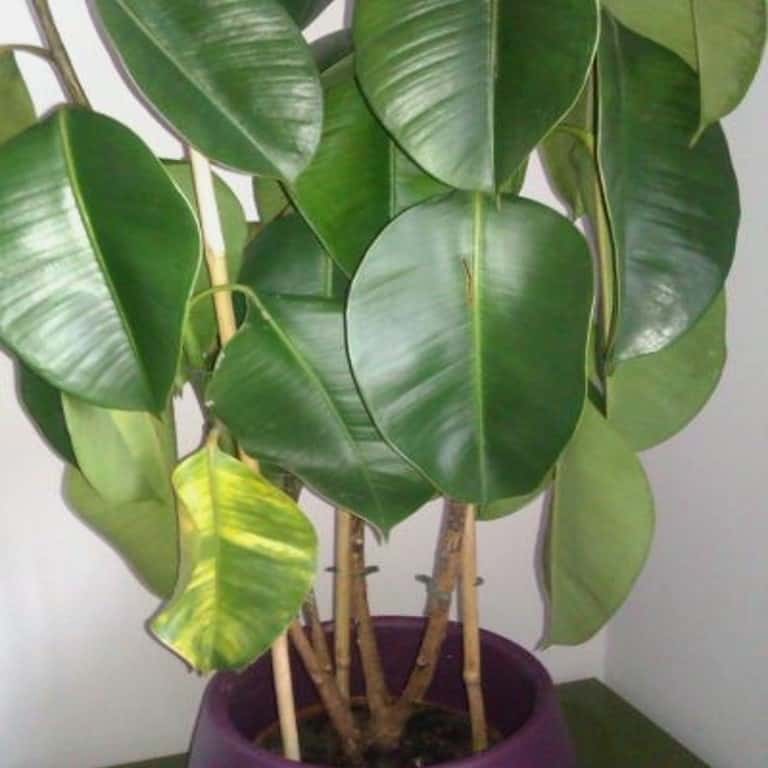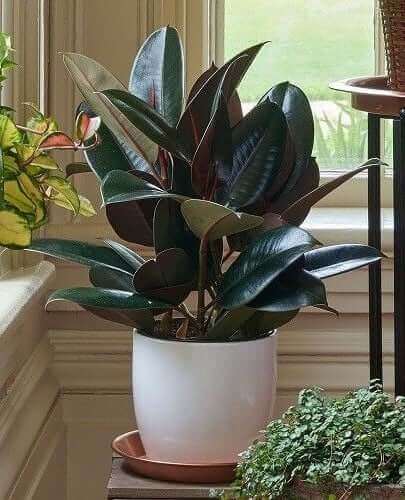Your Rubber plant dropping lots of leaves? And downward dropping leaves are also turning yellow or brown and falling down?
You don’t know what should you do? Don’t worry you are not alone who are facing this problems. And you know why do the rubber plant leaves droop is one of the most asked questions in the gardening forum.
Here I am going to assist you to identify actually what happened to your rubber plant and what steps you should take.
The Possible Reasons For Dropping Rubber Leaves
First, you have to know why the leaves are drooping on the rubber plant. There are many reasons for dropping and falling leaves. Here are some possible reasons-
- Loss the turgor pressure (water pressure between the plasma membrane and cell wall) of rubber plants. Over and under-watering are the main reasons for losing turgidity. A high level of salt in the soil can affect the process of osmosis that can be the reason for plant wilting. Wilting can also lose turgor pressure.
- Lack of roots development. Roots are the heart of the plant. So you should take into consideration that the roots are developing well. Small pot and container are the cause of root bounded.
- Lack of proper drainage system. Wet soil for a long time will kill the roots and prevent root development.
- Lack of essential light and an instant huge change of light can impact the rubber plant. e.g bring the rubber plant from outdoor to indoor. If your rubber plant needs staking, then it’s the time to think about the light.
- Lack of essential humidity. Generally, Rubber plant problems due to humidity observe more in winter.
- Over-fertilizing and pests can be caused by rubber plant leaf dropping. Generally, Aphids, Spider mite webbing, scale bugs, or waxy white mealybugs are common pests of rubber plants. These pests could be the cause of leave dropping and falling.
- The over-temperature and extreme cold could be the reason for rubber Plant leaves curling and drooping
How to Treat Leaves Dropping Rubber Plant?
You know the reason for the dropping and falling leaves. Now you should also know what steps you should take to treat the plant.
1. Solution for Over and Under Watering
Over and under-watering generally show the same symptoms (wilting). So it is a little bit difficult to confirm that the symptoms are for the overwatering or under-watering. Let me simplify it.
If the soil is dry and your rubber plant goes limps and become vigorous after watering. The cause of leaves dropping is under-watering. If the soil is wet or damp and plant leaves dropping. The cause is overwatering. Yellow and brown colors also indicate the overwatering. Pretty simple, doesn’t it?
How much water you should apply?
I think the answer will vary if you ask the question to a different person.
But I will give you quick tips. Always apply a large amount of water. Flush the soil with water. Why did I tell you that? Plant nutrients do not remain available form in the soil. Water will dissolve them. If you apply a small amount of water, a small amount of the nutrient will dissolve. That the reason I have told you that.
But overwatering can harm your plant. That’s why you must have a very good drainage system. Drainage holes will help to leach out the extra water. Extra water will come out with extra salt that will help to balance the level of salt.
Don’t follow this method if your plant pot doesn’t have better drainage facilities. Stick deep (about 2 inches) a wood dowel rod into the soil. Observed the rod that it comes out in wet or dry. This simple test will help you to decide when to water your rubber plant. Apply 1 or 2 inches of clean and room temp water if the surface soil remains dry.
2. Solution for Root Development and Drainage Problem
To know about the health of the root, you have to remove the plants from the pot. If the roots are bounded, repot the plant in a larger pot.
You know:
Rubber plant likes good drainage. Get off the sick plant’s root ball from the pot and let it dry for a few minutes. Fill a larger pot with the fast draining and well-aerated potting soil.
You can mix peat, pine bark, and coarse sand with a 1:1:1 ratio and also can buy potting soil. Further, don’t forget to consider that the pot has a good drainage system.
Here is the list of well drainage best pot for rubber plant and well-aerated potting soil for rubber that you can purchase-
3. Solution for The Lighting Problem
It is normal to dropping and falling leaves when climate change. But if you decide to change the place of your rubber plant from outdoor to indoor, you have to acclimate the plant fast. Hang best grow light on your rubber plant.
Our Pick-
4. Solution for Humidity Problem
Rubber plant loves humidity. As you have already known that winter has low humidity that causes leaves dropping and falling. Now the question is how to increase humidity for plants. You can increase humidity in various way such as-
- Spray on your plant with fine mist water. Don’t mix chemicals with the water.
- Stand plants on tray gravel that fill with water but not so much. Must use a large tray or shallow ceramic bowl.
Here is the recommended rubber plant tray and bowl–
- Place your rubber plant in a moist and humid place. Generally, the bathroom and shower are the most humid place.
- A terrarium is also useful for retaining moisture for a plant.
5. Solution for Overfertilizing Problem
I already have told you that over fertilizer may be the cause of your rubber plant’s leaves dropping. So you must be careful about fertilizer dose. Fertilizers are the foods of your plant. Never feed the plants forcefully. Always apply fertilizer evenly.
Rubber plant needs a little amount of fertilizer. Fertilize your rubber plant every 3 or 4 weeks only the growing season. Here are the recommended best amendment and liquid fertilizers for your rubber plant-
6. Solution for Insects and Bugs Problem
Observ the stems and leaves whether you find out any sign of pest infestation. Treat your rubber plant with neem oil or garlic spray.
How to apply neem or garlic spray on your rubber plant?
- Mix 1 tablespoon neem oil or liquid (mix both for quick result) extract of garlic with 1.5 liters of water.
- Pour the solution into a spray bottle.
- Spray on the foliage once a week until the insects disappear successfully.
You can make garlic spray at home. Here is another article on how to make garlic spray that will help you. Moreover, you can also buy ready-made garlic spray online. Here are the recommended neem oil fungicide and garlic spray for rubber plant-
Other Tips
- Always try to place your rubber plant at temperature 10-28 degrees Celsius. Rubber plants can survive 2 or 3 days in dark but not at low temperatures. So, You should take this matter seriously if you leave for a few days on vacation.
- Put away your plant from the air vent, fireplace, and direct sunlight. Remember, the rubber plant likes indirect sunlight.
- Report your plant in a bigger pot.
- Clean the dust of the leaves. For doing that, spray neem oil on the leaves.
- Remove the yellow leaves as you can’t save them.
- Move your rubber plant to a different place to find out the perfect bright place. But never place the plant beside the open window in the frost.
Conclusion
I hope this helped you to find out why your rubber leaves dropping or curling. Rember, It is a normal and common thing to turning older leaves into yellowish. If you change the place of the rubber plant, the dropping of a few leaves will be also normal.
Moreover, I have told every possible reason and their solution here. Now your turn. Follow the instructions that you learned and don’t neglect to take good care of your rubber plant to fix droppy leaves.



